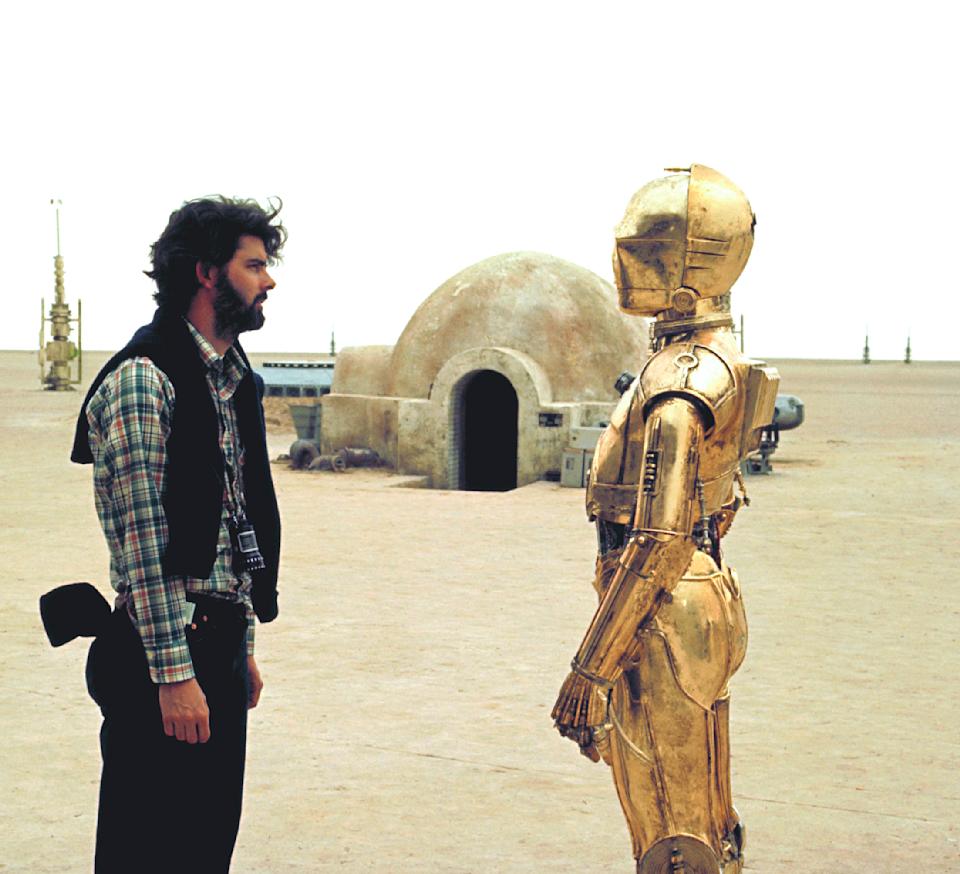You don’t have to travel to a galaxy far, far away to visit classic Star Wars locations. For the 45th anniversary of George Lucas’s industry-transforming space opera — which opened in theaters on May 25, 1977 — Yahoo Entertainment is taking fans on a virtual tour of three iconic sets that are still standing today in Tunisia. The North African republic served as the setting for the desert planet Tatooine, which plays a key role in in Star Wars: A New Hope and the nine-film Skywalker Saga as the childhood home of Jedi master Luke Skywalker. Tunisia is also central to Lucas’s own creative evolution from a young storyteller into the architect of one of modern moviedom’s most enduring myths.
The California-born writer-director first visited Tunisia in 1975 while scouting locations for the 20th Century Fox production that was then known as The Star Wars: From the Adventures of Luke Starkiller. Lucas was immediately captivated by the country’s wide-open landscapes and exotic architecture, which seemed otherworldly to a filmmaker who grew up in middle-class Modesto. Those existing structures informed many of the sets that were designed and built for A New Hope, including the Lars Homestead dome. Located on salt flats in southwest Tunisia, the dome marks the entryway to the moisture farm where Luke (Mark Hamill) grows up under the watchful eye of guardians Owen and Beru Lars.
Unmute your audio in the top right corner to explore the Lars Homestead Dome in 3D and learn 7 facts about its history. Check out The Lars Homestead Dome in AR:
In the world of Star Wars, moisture farmers like the Lars family pass through the dome’s arched entryway and travel to a subterranean courtyard via a tunnel. In reality, though, the homestead’s courtyard is located at the Hotel Sidi Idriss in the town of Matmata — miles away from the desolate salt flats. Founded in 1968, the still-operational hotel consists of five underground pit dwellings, and Pit 2 is where Lucas filmed A New Hope‘s courtyard scenes. Decades later, the director returned to Hotel Sidi Idriss during production of the prequel film Attack of the Clones to shoot a sequence where Luke’s father, Anakin Skywalker, visits a younger Owen and Beru at their homestead.
Unmute your audio in the top right corner to explore the Lars Homestead Courtyard in 3D and learn 9 facts about its history. Check out The Lars Homestead Courtyard in AR:
Another pivotal location in Attack of the Clones and its predecessor, The Phantom Menace, is Mos Espa, a bustling Tatooine spaceport that shouldn’t be confused with its neighboring hive of scum and villainy, Mos Eisley. Built in 1997 amid the Eriguet dunes, the Mos Espa set houses the marketplace where Anakin meets his first Jedi, Qui-Gon Jinn, and begins his Dark Side journey to becoming Darth Vader. After production on Attack of the Clones wrapped in 2000, Lucasfilm gifted all of the existing sets to Tunisia, and Star Wars tourism has since proven to be a boon for the local economy.
Unmute your audio in the top right corner to explore Mos Espa in 3D and learn 5 facts about its history. Check out Mos Espa in AR:
Davin Anderson owns and operates one such Star Wars-specific tour company, Galaxy Tours, which includes the Lars Homestead dome, Hotel Sidi Idriss and Mos Espa on its packed itinerary. And he tells Yahoo Entertainment that watching fans come face-to-face with the locations they’ve seen onscreen is one of the most rewarding parts of the job.
“You get to see them relive this cinematic nostalgia in the moment,” Anderson notes. “It’s always been a part of them, and now they’re experiencing it live and re-living everything about what Star Wars means to them on so many different levels. And you get to watch them have those moments over and over again at every site you go to, which makes it really unique.”
To celebrate 45 years of Star Wars, we take a peek behind Tunisa’s influence on these three Tatooine locations. Read on, you must.
The Lars Homestead Dome
Star Wars: A New Hope started production on March 22, 1976 on the Tunisian salt flats that Lucas chose for the site of the Lars Homestead’s exterior. Compared to the juggernaut the franchise eventually became, the original film was a scrappy production where props and sets were often recycled when work at one location was complete.
Built for expediency, the homestead dome was constructed out of a wooden frame, plaster walls and chicken wire. Had the camera ventured inside, audiences wouldn’t have glimpsed the working moisture farm of Lucas’s imagination — they would only have seen a young Mark Hamill crouched in the small interior avoiding the desert heat.
Lucas hired locals to be extras for the first portion of the Star Wars shoot, including Taher Khawa, who was still a teenager when he donned the now-familiar Imperial armor to play one of the six original Stormtroopers. Interviewed through an interpreter, the 60-year-old Khawa says that he accepted the job for the money, and only saw Star Wars for the first time a few years ago. “It was not rigid,” he remembers, adding that he wore the plastic costume for up to four hours at a time. “I never suffered from the heat; I could walk in it on the sand.”
Khawa spent three days on the Star Wars set, and says he didn’t learn anything about the film’s story during that time. It was only when he watched film decades later that he fully realized the grand sci-fi spectacle that he’d been a small part of. “There were starships and blasters and other worlds — how it was done 45 years ago is amazing.”
On March 29, seven days after filming began, the crew shot their final scene on the salt flats — the famous image of young Luke gazing at Tatooine’s binary sunset, yearning for the grand adventure that’s about to become his reality. The dome can be glimpsed in the foreground of that shot, and as soon as Lucas called, “Cut!” it was dismantled so the parts could be re-used at the next location.
But a memento of A New Hope‘s presence remained behind in the form of the craters that the were dug to mark the location of the Lars Homestead. Those came in handy a quarter century later when Lucas returned to Tunisia to film sequences for Attack of the Clones. Digging up the original designs from 1977, the crew faithfully recreated the dome in the same crater where its predecessor stood. That’s the structure that fans see when they arrive at the salt flats today, although it’s understandably had a good deal of maintenance work done since 2000. Anderson says that Star Wars fan groups have taken it upon themselves to repair the dome multiple times over the years, most recently in May 2022.
It should be noted that the Tunisian dome hasn’t appeared in any Star Wars film since the final shot of Revenge of the Sith, which was filmed concurrently with Attack of the Clones and featured Jedi master Obi-Wan Kenobi, leaving baby Luke with Owen and Beru. The dome was rebuilt in Jordan for the final moments of 2019’s The Rise of Skywalker, where Rey buries Luke’s lightsaber — and the lightsaber belonging to his sister, Leia — by the abandoned homestead. And the new Disney+ series Obi-Wan Kenobi uses next-gen digital technology like the Volume to recreate the location on Los Angeles soundstages.
“It would have been great if they had gone back to Tunisia [for The Rise of Skywalker],” Anderson says. “Especially for what that last scene was meant to be for the Skywalker Saga. The first time we see Luke Skywalker is coming out of the dome, so it would have been a really great connection, but it didn’t take place.”
The Lars Homestead Courtyard
Hotel Sidi Idriss opened its doors in 1968, but the site itself dates back to the 17th century, when the pit dwellings were first dug by the native people of the Matmata region. “That region has a very unique kind of soft sand clay that makes it very diggable by hand,” explains Anderson. “You can dig these large pits, and then dig into the walls to form cave rooms. The city of Matmata itself has a variety of these caved dwellings, and they’re scattered throughout the region.”
When they were originally dug centuries ago, the five pits that comprise Hotel Sidi Idriss weren’t connected by the series of tunnels that are part of the property today. The owners built those underground passageways prior to the hotel’s grand opening. That was also the period where the mural that distinguishes the Lars family dining room was painted or carved into the ceiling of the ninth cave in Pit 2. “Usually the cave rooms in these subterranean structures are white in order to light the room and regulate temperature,” Anderson notes. “But this mural was put there when the hotel opened, and because it’s connected to Star Wars, it’s now become a stereotype for all Matmata pit dwellings, even though it’s atypical!”
The Cave 9 mural was one of the things that caught Lucas’s eye when he toured the Hotel Sidi Idriss in 1975 prior to A New Hope‘s production. Ultimately, four scenes were shot in Pit 2 over a one-day shoot on April 1, 1976. As with the homestead dome, the original set dressings for A New Hope were largely taken down when filming wrapped, although Anderson says that the owners kept some of the door frame ribbings in place.
The Attack of the Clones cast and crew similarly occupied Pit 2 for only a single day — Sept. 11, 2000. Anderson says that date also marks the last time that the Star Wars franchise filmed any Tatooine-based sequences in Tunisia. “I think they’d definitely be open to having them back,” he says when asked if there’s a chance that a future film or series might return to Tunisia. “Tunisia does export itself as a friendly cinematic country.”
At the same time, Anderson acknowledges that overseas film companies still have concerns about safety in light of incidents like the 2015 attack at a resort in the city of Sousse where 38 people, including British tourists, were killed by a gunman. “That’s something that does hinder the return of big cinema projects to Tunisia. But I’ve spent years here, and I’ve never once felt unsafe.”
Certainly, the Hotel Sidi Idriss remains a popular stop for tourists, who can walk around Pit 2 and see some of the remnants of the Lars courtyard, including the aforementioned mural, some of the doors and a slowly crumbling yellow wall that dates back to Attack of the Clones. Other features are more recent, like the moisture evaporator that was placed in the dwelling by a Star Wars fan club in 2015. The hotel is also one of the only places in Matmata licensed to serve alcohol, so visitors can grab a drink in the Mos Eisley Bar or get a meal in the restaurant.
And yes, the hotel is accepting overnight reservations from aspiring Rebels, Jedi and nerf herders on their way to Tosche Station to pick up power converters. While the famous Pit 2 can’t be booked for stays (Pit 1 is similarly off-limits), the other three dwellings offer a sleeping experience that can generously be described as rustic. For example, the main toilet and shower area are communal and located in a shared tunnel. “It’s not a luxury experience,” Anderson says, laughing. “But it’s fun to sleep where Luke Skywalker slept.”
Mos Espa
Returning to the cradle of Star Wars civilization in 1997 for The Phantom Menace, Lucas and his team constructed one large set for Mos Espa at the Eriguet dunes, with additional structures at other nearby locations. Mimicking the Lars Homestead dome, the buildings consist of wood, plaster and chicken wire and many of them lack roofs as Lucas relied on early bluescreen technology to cover over those seams. Unlike the isolated homestead, though, Mos Espa is a busy place where visitors like Qui-Gon Jinn, Obi-Wan Kenobi and Jar Jar Binks can cross paths with locals like young Anakin Skywalker, who is toiling as a slave for local merchant Watto when he first gets a taste of a bigger future.
Watto’s shop is located on the west side of the Mos Espa set, and it’s distinguished from the other buildings by its round shape and the fact that it has two entrances instead of one. The scenes inside the shop were filmed on a soundstage months later, but the Tunisian structure is still a place of business. Anderson says that artisans and Bedouin people have taken up residence inside of Watto’s shop — and several of the other buildings — and sell their own crafts and other souvenirs to visitors. “They’ll have tea, they’ll store their wares, all sorts of things. Watto’s shop has the largest interior so you can walk around it and get a good feel of what the other unfinished buildings on the set are like.
Through an interpreter, Yahoo Entertainment spoke with one of the Tunisian shopkeepers who operates nearby Mos Espa, and has been selling Star Wars memorabilia from the set since the late ’90s. “I sell many things to [tourists],” he says. “They buy crazy things, like the wings of airplanes, masks and strange fruits.” Some of the most expensive items he’s sold are the droids that Lucasfilm left behind as well as props carried by Jake Lloyd, who played Anakin in The Phantom Menace. “One buyer was obsessed with Star Wars and bought many things: he told me he was born after his mother was rushed to the hospital while watching The Phantom Menace in theaters!”
Like many of the locals, the shopkeeper is bemused by the passion of the Star Wars fans who pass through the area, even if he’s not necessarily the biggest fan of the films himself. “Those kinds of movies are for younger people — not for me at my age right now.” But he still credits Lucas’s fictional world with improving his real-life circumstances. “Thanks to Star Wars I started my business, and I live through Star Wars. When I walk in the street and see people in T-shirts with Star Wars characters, I say, ‘Yes, good!’ This is my community.”
And it’s a community that Anderson expects to continue making the pilgrimage to Tunisia, even though the Star Wars franchise itself has moved on. But he believes that only adds to the mythic quality of the sets that remain behind. “I firmly believe the reason why Star Wars tourism and other film tourism is trending in popularity is because the ability to be at real locations is dwindling for big budget films,” he says. “You have fans who say, ‘I remember when films were made differently, and I want to connect to that.'”
— AR experience by Henry Keyser, Jacquie Cosgrove, Sonny Cirasuolo, Becky Horvath, Ethan Alter, Logan Davis, Fabian Rueckert, Tim Chaffee, Shah Martinez, Sam Wolson, Med Arbi Soualhia, Davin Anderson
Star Wars: A New Hope and the rest of the Skywalker Saga is currently streaming on Disney+.




